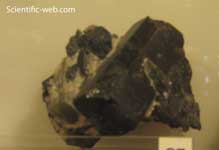| - Art Gallery - |
Hornblende is a complex inosilicate series of minerals (ferrohornblende - magnesiohornblende).[1] Hornblende is not a recognized mineral in its own right, but the name is used as a general or field term, to refer to a dark amphibole. It is an isomorphous mixture of three molecules; a calcium-iron-magnesium silicate, an aluminium-iron-magnesium silicate, and an iron-magnesium silicate. Manganese, titanium, and sodium are sometimes present. Fluorine often substitutes for the hydroxyl in the structure. The general formula can be given as (Ca,Na)2–3(Mg,Fe,Al)5(Al,Si)8O22(OH,F)2. Hornblende has a hardness of 5–6, a specific gravity of 2.9–3.4 and is typically an opaque green, greenish-brown, brown or black color. Its cleavage angles are at 56 and 124 degrees. It is most often confused with the minerals augite and biotite mica, both of which are black and can be found in granite and in charnockite. Occurrence Hornblende is a common constituent of many igneous and metamorphic rocks such as granite, syenite, diorite, gabbro, basalt, andesite, gneiss, and schist. It is the principal mineral of amphibolites. Very dark brown to black hornblendes that contain titanium are ordinarily called basaltic hornblende, from the fact that they are usually a constituent of basalt and related rocks. Hornblende alters easily to chlorite and epidote. A variety of hornblende that contains less than 5% of iron oxides is gray to white in color and named edenite, from its locality in Edenville, New York. Other minerals in the hornblende series include: pargasite, hastingsite and tschermakite. Etymology The word hornblende is derived from the German horn and blenden, to 'blind' or 'dazzle'. The term blende is often used to refer to a brilliant non-metallic luster, for example, zincblende and pitchblende, a lustrous form of uraninite.
1. ^ http://www.mindat.org/min-8789.html Mindat * Hurlbut, Cornelius S.; Klein, Cornelis, 1985, Manual of Mineralogy, 20th ed., John Wiley and Sons, New York, p 416-7, ISBN 0-471-80580-7 Retrieved from "http://en.wikipedia.org/" |
|

